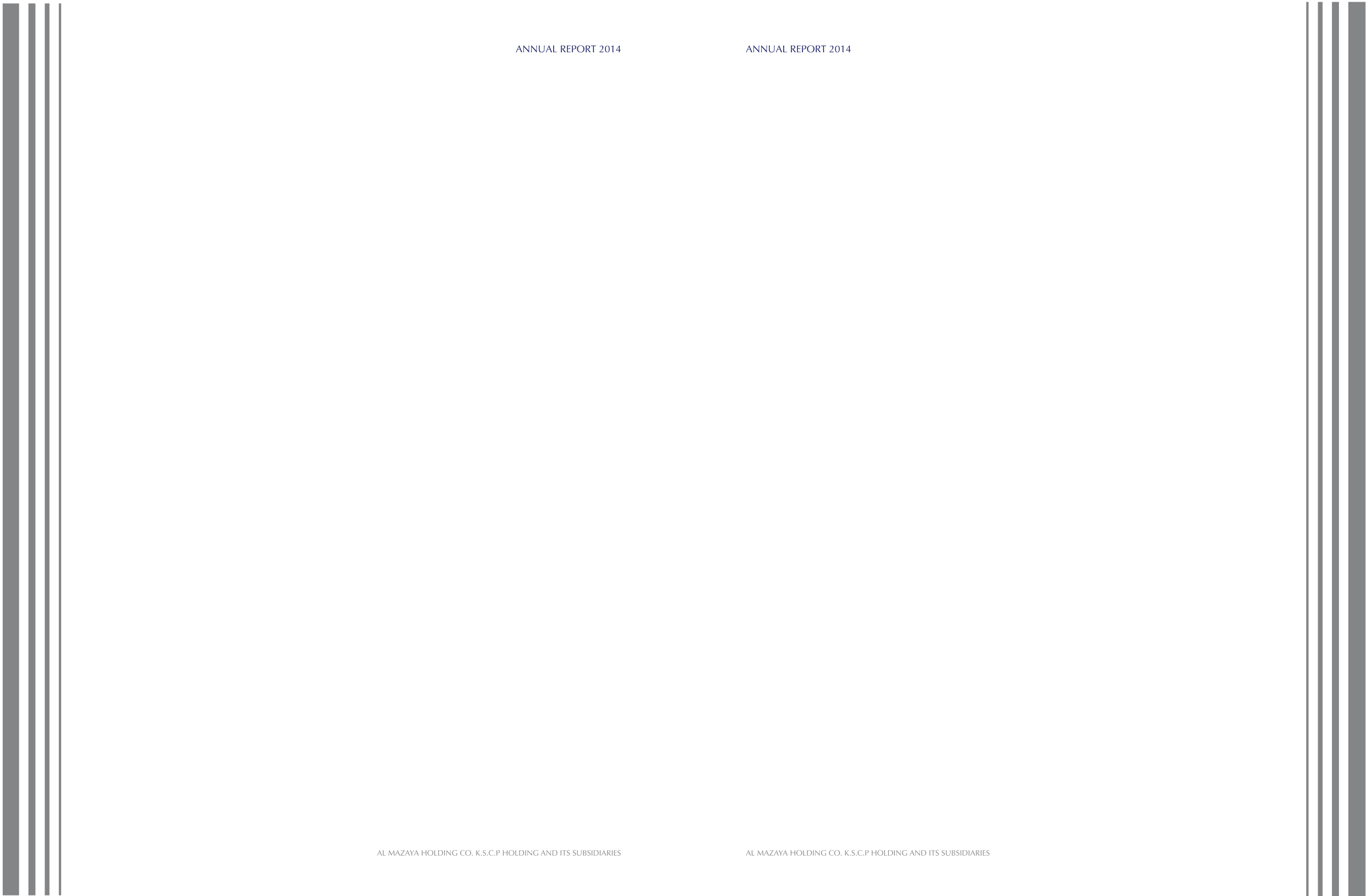
Notes to The Consolidated Financial Statement
AL MAZAYA HOLDING COMPANY K.S.C.P. AND ITS SUBSIDIARIES
31 December 2014
Notes to The Consolidated Financial Statement
AL MAZAYA HOLDING COMPANY K.S.C.P. AND ITS SUBSIDIARIES
31 December 2014
IFRS 15 Revenue from contracts with customers
The standard was issued in May 2014 and specifies how and when an entity will recognize revenue as well as requiring
such entities to provide users of financial statements with more informative, relevant disclosures. The standard provides a
single, principles based five-step model to be applied to all contracts with customers. IFRS 15 is effective for annual periods
beginning on or after 1 January 2017. The Group is in the process of quantifying the impact of this standard on the Group's
financial statements, when adopted.
Annual improvements 2010 - 2012 Cycle
These improvements are effective from 1 July 2014 and are not expected to have a material impact on the Group. They
include:
IFRS 3 Business Combinations
The amendment is applied prospectively and clarifies that all contingent consideration arrangements classified as liabilities
(or assets) arising from a business combination should be subsequently measured at fair value through profit or loss
whether or not they fall within the scope of IFRS 9 (or IAS 39, as applicable).
IFRS 8 Operating Segments
The amendments are applied retrospectively and clarify that:
• An entity must disclose the judgements made by management in applying the aggregation criteria in paragraph 12
of IFRS 8, including a brief description of operating segments that have been aggregated and the economic characteristics
(e.g., sales and gross margins) used to assess whether the segments are ‘similar’.
• The reconciliation of segment assets to total assets is only required to be disclosed if the reconciliation is reported
to the chief operating decision maker, similar to the required disclosure for segment liabilities.
Annual improvements 2011- 2013 Cycle
These improvements are effective for annual periods beginning on or after 1 July 2014 and are not expected to have a
material impact on the Group. They include:
IFRS 13 Fair Value Measurement
The amendment is applied prospectively and clarifies that the portfolio exception in IFRS 13 can be applied not only to
financial assets and financial liabilities, but also to other contracts within the scope of IFRS 9 (or IAS 39, as applicable).
IAS 40 Investment Property
The description of ancillary services in IAS 40 differentiates between investment property and owner-occupied property
(i.e., property, plant and equipment). The amendment is applied prospectively and clarifies that IFRS 3, and not the
description of ancillary services in IAS 40, is used to determine if the transaction is the purchase of an asset or business
combination.
Additional disclosures will be made in the financial statements when these standards, revisions and amendments become
effective. Expect the impact from IFRS 9, the Group, however, expects no material impact from the adoption of the
amendments on its financial position or performance.
25
52
4. SUMMARY OF SIGNIFICANT ACCOUNTING POLICIES
Basis of consolidation
The consolidated financial statements comprise the financial statements of the Parent Company and its subsidiaries as at 31
December 2014. Control is achieved when the group is exposed, or has rights, to variable returns from its involvement with
the investee and has the ability to affect those returns through its power over the investee. Specifically, the group controls
an investee if, and only if, the group has:
• Power over the investee (i.e. existing rights that give it the current ability to direct the relevant activities of the investee)
• Exposure, or rights, to variable returns from its involvement with the investee, and
• The ability to use its power over the investee to affect its returns
Generally, there is a presumption that a majority of voting rights result in control. To support this presumption and when
the Group has less than a majority of the voting or similar rights of an investee, the Group considers all relevant facts and
circumstances in assessing whether it has power over an investee, including:
• The contractual arrangement with the other vote holders of the investee
• Rights arising from other contractual arrangements
• The group’s voting rights and potential voting rights
The financial statements of the Subsidiary are prepared at the same reporting year as the Parent Company using consistent
accounting policies. Subsidiaries are consolidated from the date on which the Group obtains control and continues to be
consolidated until the date that such control ceases.
All material intra-group balances and transactions, including material unrealised gains and losses arising on intra-group
transactions are eliminated on consolidation
Non-controlling interest represents the portion of profit and loss and net assets not held by the Group and are presented
separately in the consolidated statement of income and within equity in the consolidated statement of financial position
separately from equity attributable to the equity holders of the Parent Company.
A change in the ownership interest of a subsidiary, without a change of control, is accounted for as an equity transaction.
Losses are attributed to the non controlling interest even if that results in a deficit balance.
If the Group loses control over a subsidiary, it derecognises the related assets (including goodwill), liabilities, non-
controlling interest and other components of equity while any resultant gain or loss is recognised in profit or loss. Any
investment retained is recognised at fair value.
53


